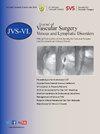Vein-first embolization is superior to transarterial approach in type IIIb arteriovenous malformations
IF 2.8
2区 医学
Q2 PERIPHERAL VASCULAR DISEASE
Journal of vascular surgery. Venous and lymphatic disorders
Pub Date : 2025-06-06
DOI:10.1016/j.jvsv.2025.102274
引用次数: 0
Abstract
Objective
To propose a modified treatment concept for type IIIb arteriovenous malformation (AVM), involving a vein-first (VF) strategy that focuses on direct puncture and coil embolization of dilated veins, followed by ethanol injection from the vein to feeding arteries. This retrospective study evaluated the safety and efficacy of this approach.
Methods
A total of 117 patients (55 males; median age, 27 years) with type IIIb AVMs were retrospectively reviewed. Patients were divided into two groups: a transarterial (TA) embolization-dominant group and a VF group, which underwent direct puncture of veins with coil embolization followed by ethanol injection. AVM characteristics, embolization techniques, number of treatment sessions, angiographic outcomes, and procedure-related adverse events were analyzed.
Results
A total of 515 procedures were performed: 117 in the VF group (n = 41) and 343 in the TA group (n = 76). No significant differences in demographics or AVM characteristics were found. The VF group achieved significantly better treatment outcomes than the TA group (88% vs 51% achieving >90% lesion improvement; P = .001). The VF group required a median of 4.2 treatment sessions per patient vs 4.5 in the TA group, and used 129 mL vs 141 mL of ethanol; those differences were not statistically significant. Procedure-related adverse events were significantly lower in the VF group (11%) than in the TA group (22.3%; P = .0009).
Conclusions
The VF strategy for type IIIb AVM achieved better outcomes and fewer adverse events than conventional TA embolization technique.
静脉先栓塞优于经动脉栓塞治疗IIIb型动静脉畸形。
目的:提出一种改进的IIIb型动静脉畸形(AVM)的治疗理念,包括“静脉优先”策略,重点是直接穿刺和线圈栓塞扩张静脉,然后从静脉注射乙醇到供血动脉。本回顾性研究评估了该方法的安全性和有效性。材料与方法:回顾性分析117例IIIb型AVM患者(男性55例,中位年龄27岁)的临床资料。患者分为两组:经动脉栓塞为主组和静脉优先组,直接穿刺静脉栓塞后注射乙醇。分析AVM的特征、栓塞技术、治疗次数、血管造影结果和手术相关的不良事件。结果:共进行515例手术:VF组117例(n = 41), TA组343例(n = 76)。在人口统计学和AVM特征上没有发现显著差异。VF组的治疗效果明显好于TA组(88% vs 51%病变改善,P = 0.001)。VF组每名患者平均需要4.2次治疗,而TA组为4.5次,使用129 mL乙醇对141 mL乙醇;这些差异没有统计学意义。VF组手术相关不良事件发生率(11%)显著低于TA组(22.3%;P = 0.0009)。结论:与传统的TA栓塞技术相比,静脉优先策略治疗IIIb型AVM具有更好的疗效和更少的不良事件。
本文章由计算机程序翻译,如有差异,请以英文原文为准。
求助全文
约1分钟内获得全文
求助全文
来源期刊

Journal of vascular surgery. Venous and lymphatic disorders
SURGERYPERIPHERAL VASCULAR DISEASE&n-PERIPHERAL VASCULAR DISEASE
CiteScore
6.30
自引率
18.80%
发文量
328
审稿时长
71 days
期刊介绍:
Journal of Vascular Surgery: Venous and Lymphatic Disorders is one of a series of specialist journals launched by the Journal of Vascular Surgery. It aims to be the premier international Journal of medical, endovascular and surgical management of venous and lymphatic disorders. It publishes high quality clinical, research, case reports, techniques, and practice manuscripts related to all aspects of venous and lymphatic disorders, including malformations and wound care, with an emphasis on the practicing clinician. The journal seeks to provide novel and timely information to vascular surgeons, interventionalists, phlebologists, wound care specialists, and allied health professionals who treat patients presenting with vascular and lymphatic disorders. As the official publication of The Society for Vascular Surgery and the American Venous Forum, the Journal will publish, after peer review, selected papers presented at the annual meeting of these organizations and affiliated vascular societies, as well as original articles from members and non-members.
 求助内容:
求助内容: 应助结果提醒方式:
应助结果提醒方式:


